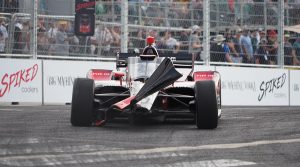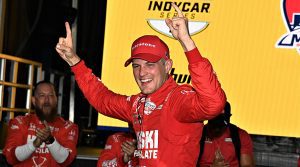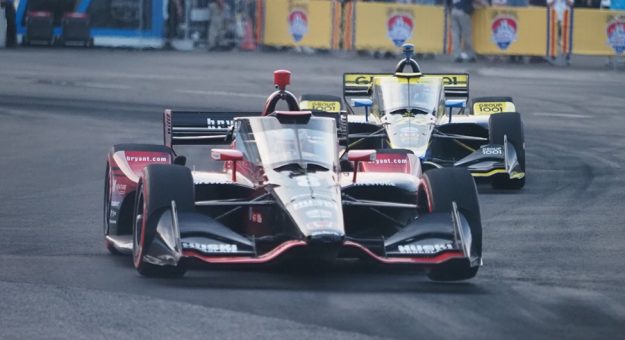NASHVILLE – Instead of spin and win, Marcus Ericsson did a fly and finish first in Sunday’s Big Machine Music City Grand Prix on the streets of Nashville.
Ericsson was involved in a crash with Sebastien Bourdais during a restart on lap five that saw Ericsson’s No. 8 Chip Ganassi Racing Honda climb over the back of Bourdais’ No. 14 A.J. Foyt Racing Chevrolet.
That launched Ericsson’s car several feet into the air before it landed on all four wheels with a thud.
RESULTS: Big Machine Music City Grand Prix
The crash damaged the front wing of Ericsson’s Honda and he quickly made his way to the pits during the caution period to repair the damage.

In a race that ranged from the unusual to the ridiculous, circumstances played in Ericsson’s favor to be in the lead during the final 22 laps of the race.
With Ericsson on Firestone Red tires, and the best car in the field driven by pole winner Colton Herta chasing him in second, Herta was never able to get close enough to Ericsson to make the pass.
Ericsson had superior speed on the straights and when Herta locked it up trying to pass the leader 11 laps from the finish, he lost a significant amount of time. Ericsson was able to go fast enough to stay ahead of Herta, but slow enough to save fuel.
Then, to add to the bizarre nature of this race, Herta slammed into the turn nine wall with five laps to go.
“Tunnel vision, man. I feel terrible. We had the race to win and I threw it away. I feel terrible,” Herta said. “I don’t know what else to say. This race was brutal. Good job to Marcus. I feel terrible for the team.
“It was terrible on my part. I knew he had to save fuel. I didn’t know how close it was going to be. I was just pushing to get ahead of him as soon as I could and I just overdid it. He had a lot more push-to-pass than I did.”
The race was red flagged to allow for a green flag finish, although darkness was closing in on the 11-turn, 2.1-mile street course.
That was all that Ericsson needed to drive to the second victory of his career as darkness fell on Nashville.
“It’s unbelievable and shows in IndyCar that anything can happen and never give up,” Ericsson said. “If you have a good car, you can still win the race.
“The Honda was great, and the power was great all day, I just can’t believe it. I think this is the best drive of my career. I had to save fuel and keep Colton Herta from behind and that is one of the best performances of my career. I’m so proud of the whole team and I’m so thankful.
“I also want to apologize to Sebastien Bourdais for that crash at the start.”
Ericsson drove from 18th to first and even had to serve a penalty after running into the back of Bourdais.
The race featured numerous crashes, including a multi-car crash on lap 20 in turn 11 that blocked the race course and brought out the first red flag of the race. It began when Team Penske drivers Will Power and Simon Pagenaud went side-by-side into turn 11 and made contact.
That sent Pagenaud’s car into the wall and he was soon joined in the carnage by Ryan Hunter-Reay, Rinus VeeKay, Takuma Sato, Jimmie Johnson, Romain Grosjean, Helio Castroneves, James Hinchcliffe and NTT IndyCar Series points lead Alex Palou.
Johnson, who crashed his primary car in the Sunday warmup, was driving a Chip Ganassi Racing backup car and was experiencing electrical issues. During the red flag period, Johnson’s crew put the car on the airjacks to assess what needed to be repaired and that violated the no working on a race car during a Red Flag rule. IndyCar informed Johnson’s team that he was out of the race.
The red flag was lifted after 20 minutes, but the incredibly bizarre nature of this race continued.

Ericsson joined Herta, Rossi, Dixon, Grosjean, Pato O’Ward, Graham Rahal and Santino Ferrucci as drivers who made a pit stop on lap 32 after VeeKay stuffed his car into the tire barrier in turn two on lap 31. That put Ericsson into a fuel cycle that would fall into his favor later in the race.
Just past halfway, a lengthy caution period was called because of water on the track. It took quite a while clean up the water on the course, and it began to appear there was no way the race would make it the full 80-lap distance.
IndyCar officials persevered and after another red flag following Herta’s crash to repair the retaining wall, a two-lap dash to the checkered flag was set with teammate Scott Dixon behind Ericsson.
Ericsson hit the throttle in turn 11, took the green flag and was able to maintain his distance over Dixon’s No. 9 Honda.
At the checkered flag, Ericsson beat Dixon by 1.5596 seconds for his second win this year and second IndyCar win of career.
Hinchcliffe’s No. 29 Honda was third followed by Andretti Autosport teammate Hunter-Reay. Graham Rahal rounded out the top five.
Ed Jones finished sixth after driving up from the back and Palou finished seventh.
Josef Newgarden of nearby Hendersonville, Tenn., finish 10th, the highest finishing driver from Team Penske as the rest were all involved in crashes or had other issues.
Ericsson joins Palou and O’Ward as the only drivers in the series with two victories this season.
Palou continues to lead the points by 42 over Dixon, 48 over O’Ward, 75 over Newgarden and 79 over Ericsson. Dixon started the day 56 points behind the leader in third.
